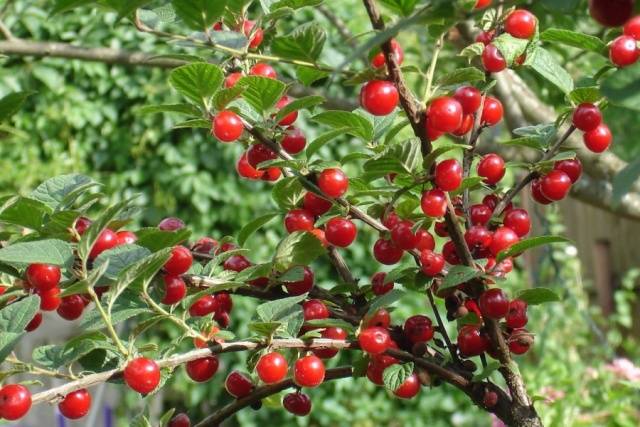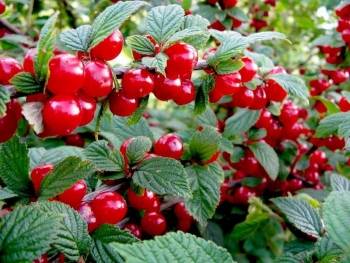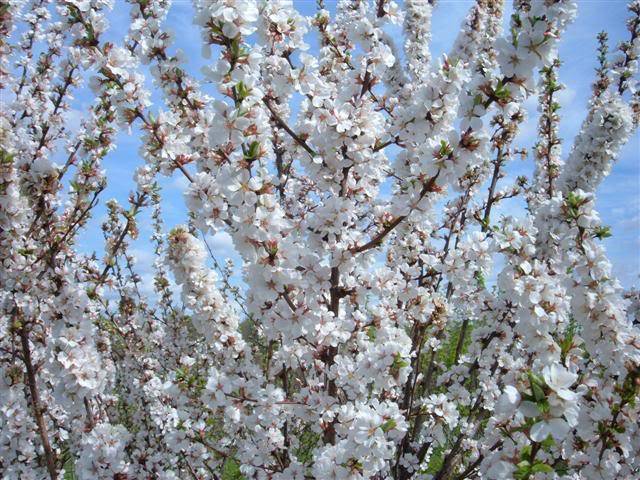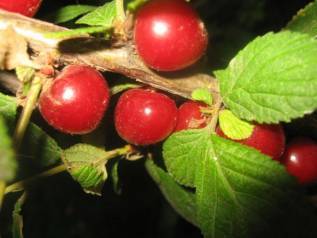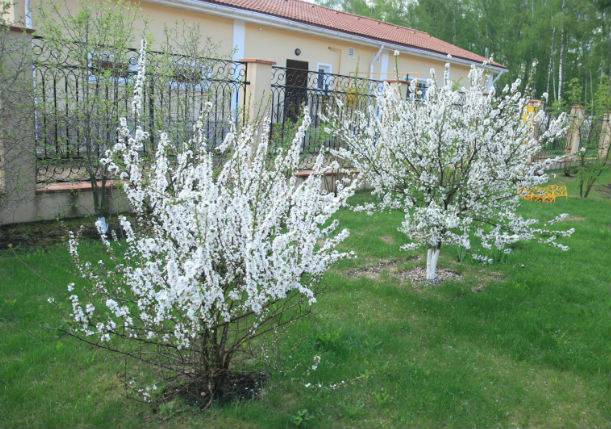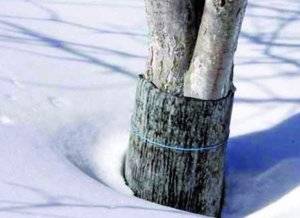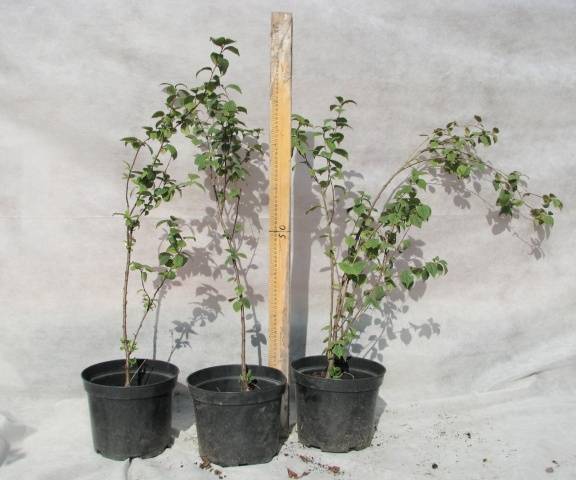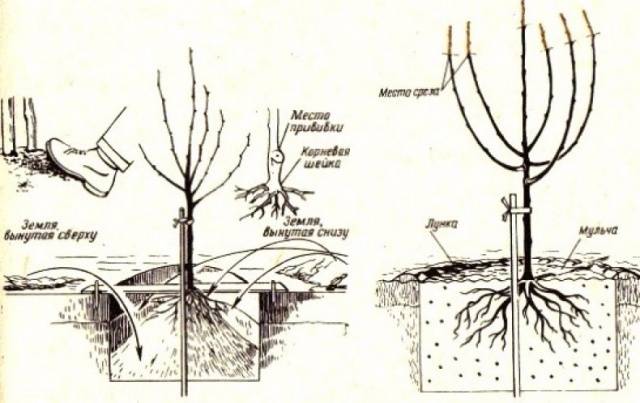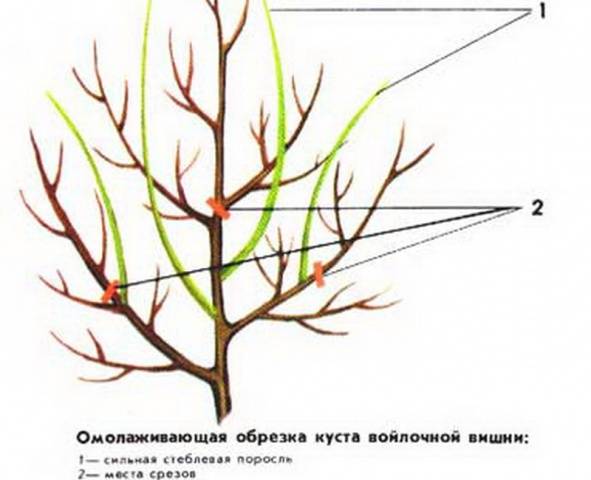Content
Felt cherry Princess is less whimsical in care than ordinary cherry. This variety has a high resistance to diseases and climatic disasters, and high yield rates with a relatively small bush size have long been the reason for the high popularity of this crop variety among gardeners.
Breeding history
From the point of view of biology, this short tree is not a cherry, it belongs to the genus of plum (Prunus), the Pink family. Only its fruits are similar to the cherries familiar to everyone.
Felt cherry variety The princess, like many other excellent varieties, was obtained by breeders of the Far East, employees of the experimental station VNIIR V.P. Tsarenko and N.A. Tsarenko in 1977. Felt cherry Leto and Red sweet became the parents of the variety. The variety was registered in the State Register in 1999. A photo of a felt cherry princess is presented below.
Description of cherry variety Princess
Felt cherry Princess grows well and bears fruit well in any region of Russia.
First of all, the Tsarevna cherry variety is a small bush with a height of only 1.2 to 1.4 m. Its crown is wide-oval, not very thickened. Perennial shoots of Tsarevna cherry grow straight and have a brown-gray color, on which light lentils are clearly visible. Peeling for the bark is common in this variety. Young red-brown twigs of the Princess are pubescent. Small buds are located in groups, 3 in each axil of the leaf.
Leaves
Small, pubescent and corrugated felt cherry leaves have the shape of a slightly elongated oval with a double-toothed edge. They taper towards a sharp top and base. The short petiole is also covered with fluff.
Flowers
The Princess's flowers are not too large, about 2.5 cm in diameter. Five loosely spaced white petals form a corolla. It has 24 stamens and 1 pistil, which has pubescence and ovary. Its stigma rises above the anthers of the stamens. The calyx, shaped like an elongated oval, has a pronounced anthocyanin coloration and pubescence. During flowering, the Tsarevna's cherry tree is a real decoration of the site, since it blooms very profusely and resembles a real princess in a snow-white outfit.
Fruit
The shoots of all ages at the Tsarevna's cherry are covered with fruits. They are located on each fruit twig and bouquet twig.
For such a small tree as the Princess, the berry is large enough and can reach a weight of 4 g with a diameter of 1.7 cm. Its ovoid shape seems a little irregular due to the beveled top. A tiny beak can be seen at the stalk. A deep funnel is noted at the point of attachment of the berry to the stalk. The stripe on the berries is the abdominal seam that distinguishes this variety from others.
The berries of the Princess cherry are shiny, slightly pubescent, which is typical for all varieties of this type of culture. They delight with a bright pink color. The juice from them turns out to be light red, the same as the pulp of the cherry.The stalk is short and does not even reach a centimeter in length, so it seems that the Princess's tree is covered with fruits. A small bone is not able to separate from the pulp. It is light brown, and its mass is only 1/20 of the total mass of the berry.
Cherry berries of the Tsarevna variety have a sweet and sour pleasant taste, as evidenced by the tasting score - 3.8 points out of possible 5. The content of ascorbic acid reaches 18 mg for every 100 g of product, and they contain much more sugars than acids: 8.2 and 0.67%, respectively.
The separation from the fruits is semi-dry, but it is impossible to harvest the crop using a mechanized method. Therefore, this variety is rarely chosen for growing on an industrial scale.
Characteristics
It is the characteristics of the felt cherry that the Princess will suggest the optimal conditions for the existence of the plant, the area of application of the fruits.
Drought resistance, winter hardiness
For growing cherry Tsarevna moist soil is completely unsuitable, since the variety does not tolerate moist soil well. But it can withstand drought very well. The variety is winter-hardy and frost-resistant. Due to the small size of the bushes, it will calmly endure the winter in any climatic conditions, hiding under the snow cover.
Pollination, flowering period and ripening times
Since the felt cherry belongs to the genus of plum, it will not be pollinated with ordinary cherries.
Flowers of this variety do not bloom at the same time. The flowering of the Princess lasts up to 2 weeks and falls in the second decade of May. But cherry fruits ripen almost simultaneously, in the third decade of July.
Productivity, fruiting
For such a miniature plant, the yield of the variety is very high. Almost 10 kg of berries can be harvested from each bush.
If the princess's seedlings are own-rooted, then the first harvest can be harvested in the fourth year. In grafted plants, this period is shorter. The first berries are picked in the second year after planting.
The duration of fruiting of felt cherry is rather short in comparison with other plant species. The longevity of the Princess bush is only 17 years old, which is very good for a felt cherry.
Scope of berries
The versatility of using cherries is another plus in the treasury of its advantages. The fruits of the Princess can be eaten fresh, any preparations and desserts can be made. Winemakers often use it to make wine.
Disease and pest resistance
The Felt Cherry Princess is a fairly persistent tree. But with good resistance to coccomycosis and relative - to clasterosporium, she can get sick with moniliosis. Trees growing in moist soil are especially affected by it.
Among the pests of felt cherry, rodents come out on top, which in winter gnaw the bark at the base of the trunks, which leads to the death of the tree.
Advantages and disadvantages
The variety has a high industrial value due to such advantages as:
- yield;
- ease of reproduction;
- unpretentious care;
- good taste and considerable size of the fruit;
- excellent winter hardiness of the variety;
- resistance to return frost.
The disadvantages of the variety include the fact that with a high workload of the bush, the berries become smaller. Low resistance to moniliosis will also require additional protective measures from gardeners.
Features of planting cherry varieties Tsarevna
A good harvest and disease resistance will only be demonstrated by a tree planted correctly and on time.
Recommended timing
For the Princess, both spring and autumn planting is possible.In the fall, the tree is planted after the end of leaf fall, but a month before the onset of stable frosts. It will take this time for him to root.
In the spring, the princess is planted before the swelling of the kidneys begins.
If you purchased seedlings with a closed root system, then there are no restrictions on the timing of planting during the growing season.
Choosing the right place
On soils with a high groundwater table, this plant may simply die. A large amount of moisture causes root rot. Not suitable for felt cherries and low-lying areas where water stagnates. Basic conditions for successful growth:
- well lit place;
- drained, loamy or sandy loam, humus-rich, non-acidic soil.
What crops can and cannot be planted next to cherries
This short bush does not like shading, therefore, the neighborhood with large seed crops (apple or pear) is undesirable for it.
The felt cherry Tsarevna gets along well with a sweet cherry or cherry, if they grow from the north side. But all nearby crops must be resistant to moniliosis, so as not to infect the felt cherry. She is friends with grapes, mountain ash, hawthorn, provided that they will not shade her.
Selection and preparation of planting material
Felt cherry is a fast-growing culture. The optimal planting material is a one-year or two-year-old.
It is desirable that the height of the Tsarevna's sapling should not be more than a meter. When choosing them, you need to pay attention to the condition of the roots and trunk.
- At the age of two, they should have several lateral branches.
- The bark is not dry and intact.
- The root system is well developed, with a sufficient number of lateral suction roots.
Before planting, it will be useful to soak them in water with a rooting stimulant, which is dissolved in accordance with the instructions. Experienced gardeners advise pruning the roots before planting, leaving them 25 cm long. In this case, the plant will develop a fibrous root system with a large number of lateral suction roots. Slices must be processed with crushed charcoal or clay mash.
Landing algorithm
Correct planting is a guarantee of longevity and health of the felt cherry Princess. Fertilize the soil before planting. For 1 m², make:
- up to 3 buckets of organic matter, but not fresh manure;
- on acidic soils - up to 800 g of lime;
- phosphorus fertilizers - up to 60 g;
- potash - up to 30.
We plant correctly:
- the depth and width of the pit is 60 cm, since the cherry root system develops in the surface layer of the soil;
- pour fertile soil at the bottom so that a mound is obtained;
- place the seedling, gently spreading the roots;
- sprinkle the root system with the same soil, making sure that there are no voids in it;Warning! It is unacceptable to deepen the root collar.
- Lightly compact the soil;
- water, spending 1 to 2 buckets of water for each seedling;
- to mulch the trunk circle, it is better if humus or peat is used for this.
The planted tree should be watered once a week. When planting, do not forget to shorten the branches by about a third to balance the aboveground and underground parts.
Follow-up care of the culture
Caring for the felt cherry Princess consists of dressing, watering, pruning.
A necessary operation for her will be the prevention of moniliosis.
In the first year after planting, the Princess does not need to feed the cherry. Starting next year, the following fertilizers are applied to the near-stem circle (along the perimeter of the crown) after flowering:
- organic bucket;
- 70 g of phosphate fertilizers;
- 30 g - nitrogen;
- 20 g - potash.
Liming of the soil is carried out every 5 years.
The princess is drought-resistant, so watering is required only if there is no rain for a long time. It is also necessary at the time of pouring berries.
Felt cherry pruning is annual and rejuvenating. It is made every 5 years - this is the life span of fruiting shoots.
With annual pruning, leave 10 to 12 of the strongest shoots. If the growth of annual branches is too strong (more than 60 cm per season), they are shortened by a third.
Rejuvenating pruning is a more complex procedure. It will be necessary to lighten the center of the crown and skeletal branches along the periphery. Some of the lateral shoots are cut into a ring. All this contributes to the growth of young branches.
Cherry Princess is a fairly winter-hardy culture. Preparation for winter consists in the introduction of potassium-phosphorus dressings in September and water-charging irrigation after leaf fall.
You need to worry about protecting cherries from rodents more thoroughly. With the help of special nets or spruce branches, they protect the lower part of the trunks. Poisoned baits or just a rag soaked in kerosene are placed next to the bushes. Rodents don't like strong smells.
For more information about the intricacies of growing felt cherries, see the video:
Diseases and pests, methods of control and prevention
The main enemies of the Princess cherry are fungal infections. Information about them can be found in the table.
Disease | How does it manifest | Treatment | Prophylaxis |
Moniliosis | Leaves and flowers wither, then the branch dries | Removal of diseased shoots, treatment with 1% solution of foundationol | Timely crown thinning |
Pocket disease | Seedless fruits in the form of elongated sacs | Removal of diseased plant parts, spraying with systemic fungicides | 1. Choosing the right landing site 2. Timely pruning 3. Treatment with copper-containing preparations |
The tough, pubescent leaves of the cherry Tsarevna are not very popular with pests, so they usually do not exist on her. The main enemies are rodents. How to deal with them is described above.
Conclusion
Felt cherry Tsarevna has a lot of advantages, among which one can note unpretentiousness in care, rather high yield with a relatively small size of the bush, and excellent taste of berries. a wide area of application of ripe fruits will allow you not only to enjoy fresh cherries, but also to prepare them for the winter.
